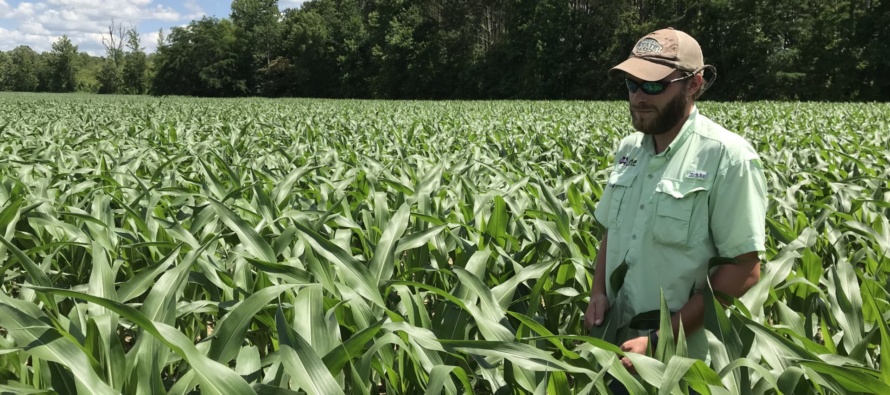Optimizing Corn Response to Nitrogen Fertilizer

Related Articles
- 2010 Soybean And Corn Variety Trial Data 3
- Fertilizing Cotton with Poultry Litter 5
- Spring Nitrogen Fertility Suggestions for Wheat 0
Latest Tweets
Mississippi’s warm, wet climate can pose considerable issues with nitrogen fertilization for corn, which is quite responsive and demands high amounts for optimal productivity. The South’s warm, high rainfall climate greatly increases potential nitrogen loss through volatilization, denitrification and leaching, compared to drier and colder climates. Of course, the corn growing season is quite long, encompassing considerable time during the spring and early summer when rainfall is normally plentiful, leading to extended soil saturation, which will promote significant nitrogen loss. Likewise, supplemental irrigation may also compound issues associated with nitrogen management. Therefore, optimizing your crop response to nitrogen fertilizer will undoubtedly involve considerably more planning and management than simply applying a given fertilizer rate.
Your primary goal for improving corn response to nitrogen fertilizer should be to minimize nitrogen exposure to wet conditions, while still meeting crop demand. We can improve this dynamic by using split applications of nitrogen dependent upon crop growth stage. During early corn vegetative stages, plant nitrogen needs are very low, while rainfall is normally high. Therefore, applying only a small portion of total nitrogen near or shortly following emergence can greatly reduce your nitrogen exposure to unfavorable conditions promoting loss. Subsequent “split” or “topdress” applications should contain the bulk of the crop seasonal nitrogen needs.
For example, although corn doesn’t require much nitrogen during early vegetative growth stages, you need to apply a modest amount of about 30 to 60 lbs/a of nitrogen (10 – 20% of seasonal total) by the time it gets 4 to 6 inches tall, or slightly later if you applied a starter fertilizer. Corn begins rapid growth and nitrogen uptake at about the V5-6 growth stage. This is the key stage for your ground-applied nitrogen operation or side-dress application which supplies the bulk of seasonal crop needs. A practical goal for side-dressing or injecting liquid nitrogen is when corn reaches V4 – V6 growth stage (8 to 18 inches tall). A pre-tassel application can also be incorporated as simply another split in your system to improve nitrogen efficiency. This method may improve fertilizer efficiency by reducing fertilizer exposure to soil saturation and resultant losses.
The figure below illustrates a suggested schedule for sidedressing nitrogen on corn. The green graph represents nitrogen uptake relative to corn growth and serves as a basis for optimal nitrogen timing. The numbers note the amount of nitrogen applied at each specific timing. If you do not employ a pre-tassel application of urea, this portion of nitrogen can be applied in the sidedress application.
Top-dressing urea is also becoming more popular method for growers in the Midsouth. However, there are inherent drawbacks with this method that may increase risk, compared to the traditional side-dress method of injecting liquid nitrogen solution in the soil. Top-dressing urea requires rainfall or over-head irrigation to successfully incorporate nitrogen and prevent volatility loss. This can present issues, if we experience a lengthy dry spell encompassing key application time, which may happen at times during May. This is why reliance on top-dress urea fertilizer is not common in drier regions of the U.S. We strongly recommend using a urease inhibitor containing the active ingredient NBPT, such as Agrotain, Aborite AG, N-Veil, NITRAIN, NitroGain UI to limit volatility of top-dressed urea. Of course, timing urea application prior to forecast rainfall is suggested to help aid incorporation and reduce potential volatility. Additionally, avoid application to saturated or wet soils which promote loss. In order to minimize leaf burn associated with top-dress application, we generally suggest applying no more than 150 lbs/a of urea per application on corn more than three feet tall. Thus, multiple top-dress applications (usually 4 to 6) are required to meet total seasonal N demand. After the initial fertilizer is applied shortly after crop emergence, we suggest timing subsequent applications beginning at the V5 growth stage (12-inches tall).
This figure illustrates a suggested schedule for topdressing urea on corn. The green graph represents nitrogen uptake relative to corn growth and serves as a basis for optimal nitrogen timing. The numbers note the rate of nitrogen applied in individual applications. For example, 125 pounds of 41-0-0-4 per acre supplies 51 pounds of nitrogen per acre.






Thank You for this article.Thank You.I have tried to grow corn…garden in Jones, Forrest Counties off and on all my life. You know small 10 x 10 or 20 x 40 feet area’s. Seems like all the rain, huidity was hurting me. Now thanks to yall, I saw what the problem was. Dang it Boy, you ought to see it. I have 4 plots about 8 x 6ft.of Stowells Evergreen, Golden Bantam Hyb and some Truckers. Man oh man. Thank You. I am sickly. old and on my way out but thanks to yall’s articles however many seasons GOD allows me will be a success. Thanks wmr.